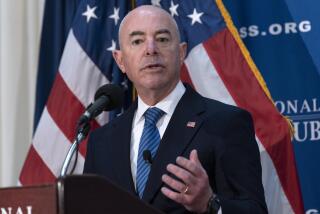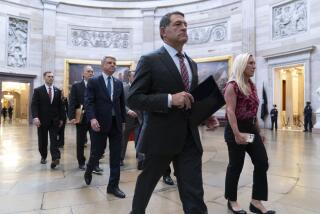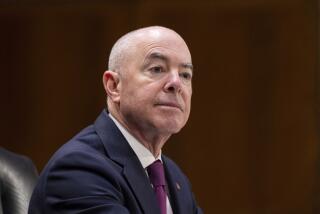Senate OKs Plan for Ground Rules in Clinton’s Trial
WASHINGTON — Reaching across a partisan chasm, the Senate on Friday finally approved a plan for conducting the second presidential impeachment trial in the nation’s history. But feuding Democrats and Republicans only postponed crucial decisions on whether witnesses will be called to testify.
Hours after a rare closed-door meeting of all 100 lawmakers, the Senate unanimously approved a resolution that calls for oral arguments to begin next Thursday, gives each side a total of 24 hours to make its case and specifies that the Senate will decide later which witnesses, if any, should be called to testify about President Clinton’s efforts to conceal his illicit relationship with Monica S. Lewinsky.
“Today we have acted in the very best tradition of the Senate, and it is an appropriate approach for this historic, very solemn event,” said Senate Majority Leader Trent Lott (R-Miss.).
With Chief Justice William H. Rehnquist presiding, the Senate then sent to the White House a summons formally notifying Clinton of the charges against him: perjury and obstruction of justice.
The bipartisan agreement is a classic Senate compromise that puts off decisive action on major issues. It is a setback for Democrats and White House officials who had sought a flat ban on witnesses before the trial begins. But the agreement also makes it much harder for House Republican prosecutors to call witnesses.
Both sides are burdened by the fact that they will have to present their cases to the Senate without knowing whether witnesses will be called. And while Republican leaders say they hope the trial will be over by early February, there is no guarantee that the process will not drag out longer than either party wants.
“The resolution today does not wrap up everything, nor does it intend to,” said Sen. Patrick J. Leahy (D-Vt.). “But it gives us the possibility of having a short trial.”
The compromise also accomplishes one important thing sought by senators of both parties: It allows the chamber to at least begin the impeachment trial on a bipartisan note and raises the possibility that the yearlong Clinton scandal will end in the coming weeks in a manner that does not replicate the rancor of the House when it voted largely along party lines in December to approve two articles of impeachment.
“There is a tremendous desire to avoid the donnybrook of the House,” said Sen. Charles E. Schumer (D-N.Y.), a former House member who was just elected to the Senate. “But one still doesn’t know exactly where this will lead us.”
The House’s lead prosecutor of the impeachment case, Rep. Henry J. Hyde (R-Ill.), said he will live with the rules laid down by the Senate.
“We intend to use the time we have been provided to present a compelling case on the serious charges pending against the president,” Hyde said. “We also look forward to the opportunity--with Senate concurrence--to call witnesses in support of the evidence.”
White House officials said they still hope that no witnesses will be called after the two sides make their opening arguments.
“We are optimistic, we are confident, that the senators, once they see and hear this defense in this opening phase of the trial, will conclude that the articles do not justify or warrant conviction or removal from office,” said Gregory Craig, the president’s special counsel. “We remain hopeful that this matter can be resolved expeditiously and fairly.”
The Senate impeachment trial officially began Thursday when all 100 senators were sworn in as jurors. But further action was stalled amid growing partisan tensions about how to conduct the trial.
It was in part to defuse those tensions that Lott and Minority Leader Tom Daschle (D-S.D.) called Friday’s extraordinary private meeting of the Senate.
The meeting also represented an effort by the Senate, a notoriously proud institution, to reassert its prerogatives to set the course of the proceeding, amid complaints that it was being whipsawed by competing demands: the desire of the White House for no witnesses and the House Republicans’ call for free rein in calling people to testify.
Senators from both parties huddled in a little-used ornate chamber where the Senate met in the 19th century, before the contemporary chamber was built. It was as if today’s scandal-weary senators were trying to retreat to an era when the Senate was a more insular, cohesive place.
Meeting under tight security behind closed doors for more than 2 1/2 hours, senators found the barriers of partisan suspicion lowered as they gave sometimes emotional, sometimes eloquent, often highly personal speeches. Senate veterans who remembered the institution in a less divisive era urged their colleagues to put aside their partisanship.
To their surprise, senators discovered they were not as far apart as they thought. For example, members of both sides shared their concerns that allowing witnesses would result in embarrassing disclosures that no one really wants on the floor of the Senate.
“The big concern on everyone’s part is that there is no need to turn this into a circus or have any evidence on the sexual aspects,” said Sen. Pete V. Domenici (R-N.M.).
Democrats made clear that their reluctance to call witnesses “was not just some partisan desire to protect the president,” said Sen. Christopher J. Dodd (D-Conn.). “There are legitimate institutional concerns.”
But rather than impose a flat ban on witnesses, as many Democrats and the White House wanted, senators decided to put off the question of whether and under what conditions to allow witnesses.
The turning point of the meeting came when two senators at the extreme poles of the political spectrum--conservative Phil Gramm (R-Texas) and liberal Edward M. Kennedy (D-Mass.)--pointed out that the two sides’ differences were not really that great, especially on the initial stages of the process.
Although Democrats had earlier been insisting that no trial begin until a ban on witnesses had been set, the compromise that emerged from Friday’s meeting gives them a victory by creating a high bar for the calling of witnesses. But, as insisted on by Republicans, it does not rule out their appearance.
Daschle said he is confident that after senators hear the arguments of both sides they will see no need to call witnesses.
“We are very pleased with the outcome,” Daschle said.
Under the compromise, the trial:
* Will resume Wednesday for technical legal motions by both sides. That will be the opportunity for the White House, for instance, to challenge the constitutionality of the impeachment articles because they were approved by a lame-duck House.
* Will begin in earnest Thursday with opening arguments. The House will have 24 hours, probably over several days, to present its case. Then the president’s lawyers will have 24 hours.
For both sides, initial presentations will have to be limited solely to arguments about the two articles of impeachment and the public record pertaining to them. That is an important limitation sought by Democrats and a rebuff to House Republican prosecutors who had wanted to expand their case to introduce new evidence and address charges not included in the articles.
Senators then have 16 hours, spread over more than one day, to ask questions in writing, which will be posed by Rehnquist.
It is not clear how long this first part of the trial will last, but a preliminary calendar indicates it might be over by Jan. 25.
At that point, the trial will enter a critical phase. First, Democrats will have the opportunity to make a motion to dismiss the trial, ending it short of actual votes on the articles of impeachment.
But before the Senate votes on that motion to dismiss, House Republicans prosecuting the case will have three hours to argue that additional evidence not in the record needs to be introduced and that witnesses ought to be deposed. The White House will then be given three hours to respond; it could argue for witnesses of its own or it could restrict its response to an argument against witnesses and additional evidence.
At that point, the senators will vote to determine whether they have heard enough of the case or whether they need to hear more evidence, including witnesses.
If a majority of senators votes for an end to the evidence phase of the trial, the Senate will then vote on the motion to dismiss the case.
If the motion to dismiss fails, the senators will begin private deliberations, followed by votes on the articles of impeachment.
But if a majority of senators votes to allow witnesses and additional evidence, the House prosecutors can go forward with closed-door depositions of witnesses. They then must return to the Senate and make the argument that the witnesses will add substantive information relevant to the impeachment case. It will be up to the Senate to decide, by majority vote, which witnesses, if any, actually testify.
If the Senate decides that it wants to hear live testimony from any witnesses, that process will continue for an undetermined amount of time. After closed deliberations by the senators, the Senate will hold an up-or-down vote on the two articles.
Times staff writers Elizabeth Shogren, Art Pine and Edwin Chen contributed to this story.
(BEGIN TEXT OF INFOBOX / INFOGRAPHIC)
Trial Calendar: Next week’s schedule for the impeachment trial:
MONDAY, January 11: White House team’s pretrial motions due by 5 EST.
WEDNESDAY, January 13: Arguments and rulings on the president’s motions.
THURSDAY, January 14: Beginning at 1 p.m. EST, House prosecutors have 24 hours--spread over several days--to present case.
THE FOLLOWING WEEK: President’s team has 24 hours to defend the president, followed by senators’ questions. Any witnesses would be deposed in private. The Senate then would vote again on whether witness testifies.
More to Read
Get the L.A. Times Politics newsletter
Deeply reported insights into legislation, politics and policy from Sacramento, Washington and beyond. In your inbox three times per week.
You may occasionally receive promotional content from the Los Angeles Times.











